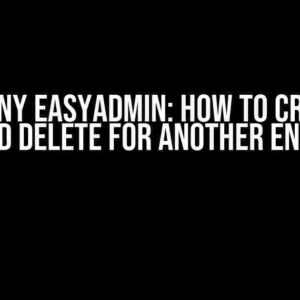Are you tired of dealing with frustrating lag in your GSAP animations? You’re not alone! Lag can be a major performance-killer, ruining the smooth and engaging user experience you’re trying to create. But fear not, dear developer, for we’re about to dive into the world of optimization techniques to help you banish lag and unleash the full potential of your GSAP animations!
Understanding the Causes of Lag in GSAP Animations
Before we dive into the solutions, it’s essential to understand the common causes of lag in GSAP animations. Here are some of the most common culprits:
- Complex Animations: Overly complex animations with multiple tweens, timelines, and callbacks can cause significant lag.
- Resource-Intensive Assets: Large images, videos, or 3D models can slow down your animation.
- Inefficient Coding: Poorly optimized JavaScript code can lead to performance issues.
- Hardware Limitations: Older devices or hardware with limited processing power can struggle with resource-intensive animations.
Optimization Techniques to Reduce Lag in GSAP Animations
Optimize Your Animation’s Timeline
A well-structured timeline is essential for smooth animations. Here are some tips to optimize your timeline:
- Use GSAP’s Timeline Features: Take advantage of GSAP’s built-in timeline features, such as
timeline.add(),timeline.insert(), andtimeline.remove(), to manage your animation’s sequence and duration. - Group Similar Animations: Group similar animations together to reduce the number of tweens and improve performance.
- Use Staggering: Staggering allows you to create a more evenly distributed animation, reducing the load on the browser.
const tl = gsap.timeline({
duration: 2,
ease: "power2.inOut"
});
tl.add(gsap.to(".box", { x: 100 }));
tl.add(gsap.to(".box", { y: 100 }), "-=0.5");
tl.add(gsap.to(".box", { scale: 1.5 }), "-=0.5");Optimize Your JavaScript Code
Here are some coding best practices to help reduce lag:
- Cache Your Selectors: Cache your selectors to reduce the number of DOM queries.
- Use RequestAnimationFrame: Use
requestAnimationFrame()to ensure your animation is updated only when the browser is ready. - Avoid Excessive Callbacks: Minimize the use of callbacks, as they can lead to performance issues.
const box = document.querySelector(".box");
function animate() {
requestAnimationFrame(animate);
gsap.to(box, { x: 100 });
}
animate();Optimize Your Assets
Here are some tips to optimize your assets for better performance:
- Compress Your Images: Use image compression tools to reduce the file size of your images.
- Use SVGs: SVGs are often smaller and more efficient than raster images.
- Use Video Optimization Techniques: Use video optimization techniques, such as lazy loading and codecs, to reduce the file size of your videos.
| Image Format | Avg. File Size (KB) |
|---|---|
| PNG | 100 |
| JPEG | 50 |
| WebP | 30 |
| SVG | 10 |
Hardware and Browser Optimization
Here are some hardware and browser optimization techniques to help reduce lag:
Hardware Optimization
Here are some hardware optimization techniques to help reduce lag:
- Use a Powerful Device: Use a device with a powerful processor and adequate RAM to handle resource-intensive animations.
- Update Your Browser: Ensure your browser is up-to-date, as newer versions often include performance improvements.
Browser Optimization
Here are some browser optimization techniques to help reduce lag:
- Enable Hardware Acceleration: Enable hardware acceleration in your browser to offload animation rendering to the GPU.
- Disable Unnecessary Plugins: Disable unnecessary plugins, such as Flash, to reduce the load on the browser.
Conclusion
In conclusion, conquering lag in GSAP animations requires a combination of optimization techniques, including timeline optimization, coding best practices, asset optimization, and hardware and browser optimization. By following these guidelines, you’ll be well on your way to creating smooth, engaging, and lag-free animations that will delight your users. Remember, optimization is an ongoing process, and continuous testing and refinement are essential to achieving optimal performance.
So, what are you waiting for? Get optimizing and banish that lag for good!
This article is part of our comprehensive guide to GSAP animation optimization. Stay tuned for more articles on advanced topics, such as animation debugging and performance metrics. Happy animating!
Frequently Asked Question
GSAP animation got you stuck in a laggy limbo? Worry not, friend! We’ve got the solutions to get your animations running smoothly in no time.
What causes lag in GSAP animation?
Lag in GSAP animation can be caused by a combination of factors, including poor browser optimization, excessive use of CPU-intensive effects, and inefficient coding practices. Don’t worry, we’ll help you pinpoint the culprit and get your animation running like a charm!
How can I optimize my GSAP animation for better performance?
Easy peasy! Optimize your animation by using the `will-change` property, leveraging browser caching, and utilizing GSAP’s built-in optimization tools. You can also simplify your animation by reducing the number of elements being animated and using hơn-efficient algorithms.Boom!
What’s the deal with render layers in GSAP?
Render layers in GSAP allow you to group animation elements for better performance. By separating complex animations into distinct layers, you can reduce the computational overhead and make your animation run more smoothly. Think of it like a layered cake – separate the ingredients for a lighter, fluffier result!
Can I use GSAP with other animation libraries?
GSAP plays nice with other animation libraries, but beware of potential conflicts! When combining GSAP with other libraries, ensure you’re not duplicating efforts or causing animation schizophrenia. Keep it harmonious by using GSAP’s compatibility mode or carefully integrating the libraries for a seamless performance.
How can I troubleshoot lag in my GSAP animation?
Troubleshooting lag? No problem! Use GSAP’s built-in debugging tools, like the Timeline and the Debugger, to identify performance bottlenecks. You can also use browser dev tools to monitor CPU usage and memory allocation. And if all else fails, simplify, simplify, simplify!



